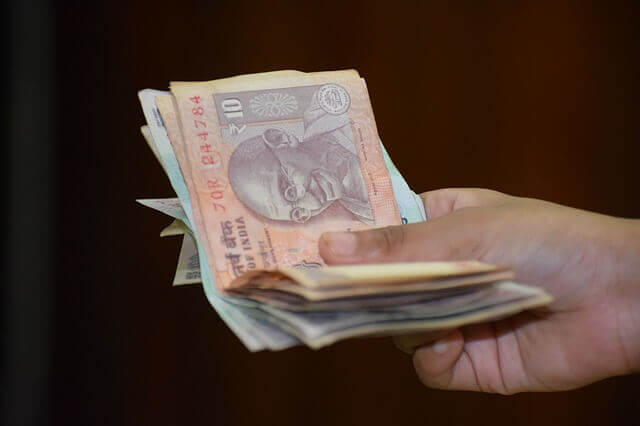Rupee Devaluation or Depreciation
 You might have heard news headlines like “Indian rupee falling” or “Rupee falls to Rs.70 against US dollar”. Have you ever wondered why rupee is falling? Who fixes the value of the Indian rupee as Rs.70 per 1 US dollar?
You might have heard news headlines like “Indian rupee falling” or “Rupee falls to Rs.70 against US dollar”. Have you ever wondered why rupee is falling? Who fixes the value of the Indian rupee as Rs.70 per 1 US dollar?
Let’s us discuss in this post a few confusing concepts in economics related to the currency market. We shall see in this article, the difference between Rupee Devaluation and Rupee Depreciation.
Let’s also trace the value of Indian rupee with respect to US dollar from 1947 and see how a fall in rupee value affects exports and imports.
Who fixes the value of Indian Rupee against US dollar?
Interesting question. Do you think the Indian government fixes the value of Indian Rupee against US dollar?
If not, who fixes it?
RBI?
No.
At present, none of these entities fixes the value of Indian Rupee. Now the value of Indian Rupee (or any other currency) is determined by the market.
Yes, Market!
Here market means the currency market.
The demand and supply forces in the currency market determine the price of each currency.
If the demand for Indian currency is high, Indian rupee will appreciate (for example 1$ = Rs.40), and if demand is low, it will depreciate (for example, 1$ = Rs.70).
If market forces determine the value of a currency, that type of system is called Floating Rate System. India has adopted the partial floating rate system since 1975, and from 1993 is fully dependent on Floating Rate System.
This means that our Prime Minister, Finance Minister or RBI chairperson cannot fix the currency exchange rate at the click of a button. But they still have some control – through policy measures or by controlling foreign exchange reserves.
Fixed Rate System vs Floating Rate System
If the government or RBI fix the exchange rate of a currency (and does not allow any variations according to demand and supply forces in the market), such a system is called the Fixed Rate system. It is also called the Bretton Woods system or Pegged Currency System.
India was following this kind of system till 1975 and partial controls followed until 1993. Since this currency valuation mechanism is artificial, most of the countries including India changed to Floating Rate System where currency market determines the value of a currency.
Rupee Devaluation vs Rupee Depreciation
The term devaluation is used when the government reduces the value of a currency under Fixed-Rate System. When the value of the currency falls under the Floating Rate System, it is called depreciation.
Revaluation is a term which is used when there is a rise in currency value in relation with a foreign currency in a fixed exchange rate. In the floating exchange rate regime, the correct term would be appreciation.
Note: Altering the face value of a currency without changing its foreign exchange rate is a redenomination, not a revaluation.
History of Indian Rupee: A comparison of Indian Rupee Value vs US dollar
Remember that we were following a fixed rate system till 1975. We had partial controls on currency market till 1993 when as per IMF standards we liberalized our entire economy.
- 1947: 1 US$ = 1.00 INR (Sounds interesting, huh? :-))
- 1948: 1 US$ = 4.79 INR.
- 1965: 1 US$ = 4.79 INR.
- 1966: 1 US$ = 7.57 INR.
- 1971: 1 US$ = 8.39 INR.
- 1985: 1 US$ = 12.0 INR.
- 1991: 1 US$ = 17.9 INR.
- 1993: 1 US$ = 31.7 INR.
- 2000: 1 US$ = 45.0 INR.
- 2013: 1 US$ = 60.0 INR.
- 2017: 1 US$ = 65.0 INR.
- 2018: 1 US$ = 70.0 INR.
The value of the Indian Rupee: Does it matter?
It should not be forgotten that the exchange rate of a currency is not really an indicator of the economic strength of a country.
There are many countries including China which favours the devaluation of the currency.
Also, the economic position of India in 2017 is far better than that of 1947, though there is a fall in Rupee value.
At present what should worry the Finance Minister and RBI governor should not the falling Indian Rupee, but the fluctuations in the currency market. What India needs is stabilization of Indian Rupee value, be in Rs. 50, Rs.60 or Rs.70 per 1 US dollar. But if rupee is Rs.60 one day and if it Rs. 65 the next day, it shows high volatility. Such a situation is not good for the economy and that will only trigger more fall in Indian rupee.
Depreciation and Appreciation of Indian Rupee: Relation with Exports and Imports
UPSC has often asked this question – directly and indirectly – how does a fall in rupee affects exports and imports? Wait, before analyzing this topic let’s see one more question  Why
Why
 Why
Why
do governments devalue their currencies?
Answer: They do it mainly to improve the balance of trade (or in other words, to increase exports and decrease imports!).
Exports vs Fall in the Indian Rupee Value: The local currency effect
 A devaluation means that more local currency is needed to purchase imports and exporters get more local currency when they convert the export proceeds (the foreign exchange that they get for their exports).
A devaluation means that more local currency is needed to purchase imports and exporters get more local currency when they convert the export proceeds (the foreign exchange that they get for their exports).
In other words: imports become more expensive; importers lose money while exporters earn more money.
This is supposed to discourage imports – and to encourage exports and, in turn, to reduce trade deficits.
Clear, uh?
Well, that was an explanation with respect to the local currency angle. Let’s see the same case analyzing the volume effect angle as well.
Exports vs Fall in the Indian Rupee Value: The volume effect
Assume that India is the exporting country and America as the importing country. India exports apples to America. Assume that India devalued India rupee from Rs. 50 =1 dollar to Rs.100 = 1 dollar. The cost of an apple in India before and after rupee devaluation is Rs.50. Now analyse what will happen.
- Before rupee devaluation: Americans will get only 1 apple for 1 dollar.
- After rupee devaluation: Now Americans will get 2 apples for 1 dollar.
Think from the American perspective. For them earlier with 1$, they used to get only 1 apple. Now after falling in Indian rupee, they get 2 apples.
So importing from India has become really cheaper for America and they will use this case to their maximum advantage.
This case will favour exporters in India in two ways:
- (1) They can now sell more apples (volume effect), trade volume will increase.
- (2) Indian currency they get when converted is now higher than before. (It was Rs.50 before, now it is Rs.100 – for 1 US$ received)
Thus, every time there is a fall in rupee against US dollar, exporters from India are benefited. (Eg: Software companies, seafood exporters etc.)
This situation badly affects importers or those who wish to visit the US for holidays as they need more local currency to get the same service or product.
Hope the confusing topic is clear for you. Leave your feedback or queries in comments.



you have explained it in very simple language for a non economics background student. thank you.
ReplyDelete